Kanamara Matsuri かなまら祭
|
Title   • File Name • File Name   • Date • Date   • Position • Position   |
|

Kanayama Jinja Shrine is a small shrine within the grounds of the Wakamiya Hachimangu Shrine near Kawasaki Daishi Station. On the first Sun. of April, it holds this now-famous Kanamara Festival nicknamed the Phallus or Fertility Festival. Festival starts at 11 am. But a large crowd was already there well before that time. Entrance to shrine on the day of the Kanamara Festival. (If you're below age 18, please leave now.)
|
|

Shrine banners and cherries in full bloomThe red banner says "Kanayama Jinja" with an phallus (erect) logo on the top.
|
|

Pumping (or humping) the...
|
|

The festival is wildly popular with people from overseas.The shrine had various phallus props to pose with.
|
|

Dickhead hat. Actually, I don't know what they call it, but that's what I call it.
|
|

Carving daikon. Anybody can join in and carve. 大根削りLater to be auctioned off.
|
|
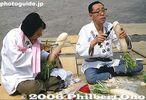
Carving daikon (old photo). These men were really good at carving the daikon.
|
|
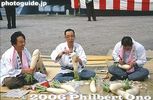
Carving daikon. Since some activities are conducted on the ground, the festival is also called Jibeta (Ground) Matsuri.Once upon a time, the festival was still mostly a local event with much fewer people.
|
|

Forging a steel phallus (old photo)The demon living in the vagina of the women bit the man's phallus each time. So one guy made a steel phallus and the demom broke his teeth.
|
|

Standing room only at Wakamiya Shrine
|
|

Packed path to Wakamiya Hachimangu Shrine
|
|

Prayers to the Kanamara Boat portable shrine かなまら舟神輿 神輿御霊入れ式Before the portable shrine is taken out to be paraded around town, the god of the shrine must be transferred to it. This is what the head priest is doing.
There are three portable shrines (called mikoshi). The Kanamara mikoshi (the original portable shrine), Kanamara-bune mikoshi (shaped like a boat), and Elizabeth mikoshi (pink giant). All three are carried during a procession around town. The Elizabeth mikoshi is carried by she-males. ("New half" in Japanese. Go ahead and laugh if you want.)
|
|

Prayers to the Kanamara-bune mikoshi かなまら舟神輿Before the portable shrine is taken out to be paraded around town, the god of the shrine must be transferred to it. This is what the head priest is doing.
|
|

The shrine's head priest transfers the deity to the Kanamara Boat portable shrine (boat-shaped loaded with a phallus) かなまら舟神輿Before the portable shrine is taken out to be paraded around town, the god of the shrine must be transferred to it. This is what the head priest is doing.
|
|

A representative of the shrine parishioners offer prayers.
|
|

Prayers to the Elizabeth portable shrine エリザベス神輿Before the portable shrine is taken out to be paraded around town, the god of the shrine must be transferred to it. This is what the head priest is doing.
|
|

Waving the sacred sakaki branch to bless all of us
|
|
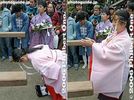
Prayers to the Elizabeth portable shrine エリザベス神輿Before the portable shrine is taken out to be paraded around town, the god of the shrine must be transferred to it. This is what the head priest is doing.
|
|

Elizabeth portable shrine エリザベス神輿Before the portable shrine is taken out to be paraded around town, the god of the shrine must be transferred to it. This is what the head priest is doing.
There are three portable shrines (called mikoshi). The Kanamara mikoshi (the original portable shrine), Kanamara-bune mikoshi (shaped like a boat), and Elizabeth mikoshi (pink giant). All three are carried during a procession around town. The Elizabeth mikoshi is carried by she-males. ("New half" in Japanese. Go ahead and laugh if you want.)
|
|

Pubic hair not included. Perhaps that's why it doesn't look so obscene.
|
|

Elizabeth portable shrine was donated by a drag queen club called Elizabeth Kaikan in Kameido, Tokyo.There are three portable shrines (called mikoshi). The Kanamara mikoshi (the original portable shrine), Kanamara-bune mikoshi (shaped like a boat), and Elizabeth mikoshi (pink giant). All three are carried during a procession around town. The Elizabeth mikoshi is carried by she-males. ("New half" in Japanese. Go ahead and laugh if you want.)
|
|

Kanamara Boat portable shrine (boat-shaped loaded with a phallus) was donated by a steel company. かなまら舟神There are three portable shrines (called mikoshi). The Kanamara mikoshi (the original portable shrine), Kanamara-bune mikoshi (shaped like a boat), and Elizabeth mikoshi (pink giant). All three are carried during a procession around town. The Elizabeth mikoshi is carried by she-males. ("New half" in Japanese. Go ahead and laugh if you want.)
|
|

Two of the portable shrines ready to go. In Japanese, the festival is nicknamed "Chinko Matsuri" (Phallus Festival) ちんこ祭り.There are three portable shrines (called mikoshi). The Kanamara mikoshi (the original portable shrine), Kanamara-bune mikoshi (shaped like a boat), and Elizabeth mikoshi (pink giant). All three are carried during a procession around town. The Elizabeth mikoshi is carried by she-males. ("New half" in Japanese. Go ahead and laugh if you want.)
|
|

The main Kanamara mikoshi かなまら神輿There are three portable shrines (called mikoshi). The Kanamara mikoshi (the original portable shrine), Kanamara-bune mikoshi (shaped like a boat), and Elizabeth mikoshi (pink giant). All three are carried during a procession around town. The Elizabeth mikoshi is carried by she-males. ("New half" in Japanese. Go ahead and laugh if you want.)
|
|

Kanamara mikoshi かなまら神輿There are three portable shrines (called mikoshi). The Kanamara mikoshi (the original portable shrine), Kanamara-bune mikoshi (shaped like a boat), and Elizabeth mikoshi (pink giant). All three are carried during a procession around town. The Elizabeth mikoshi is carried by she-males. ("New half" in Japanese. Go ahead and laugh if you want.)
|
|

Ready for the procession
|
|

Taiko drummers in front of Wakamiya Hachimangu
|
|

Wakamiya Hachimangu Shrine
|
|

Kanayama Shrine (right next to Wakamiya Hachimangu)Kanayama Shrine is dedicated to a pair of gods named Kanayama Hikonokami and Kanayama Himenokami 金山比古神(かなやまひこのかみ) 金山比売神(かなやまひめのかみ. According to legend, when the main Shinto god named Izanami gave birth to the God of Fire, her lower abdomen got burned. These two Kanayama gods helped to heal her birth wound. Thus, these two gods came to be known as the gods of childbirth and healing of the lower abdomen. They later came to be worshipped as fertility gods, protector of sexually-transmitted diseases (AIDS, etc.), and successful marriage. They are also the gods of the bellows, so blacksmiths (who use bellows to fan the fire) also worship this shrine.
Kanayama Shrine is a small shrine within the grounds of the larger Wakamiya Hachimangu Shrine. The Kanayama Shrine was completely rebuilt and reborn in 1999 into a completely unorthodox building which you see here. Modeled after a blacksmith's workshop, it is now a black, eight-sided building with steel paneling. Notice the penis monument on the lower right.
|
|

Penis prayersThis penis monument (built in 1995 by a steel company) is next to Kanayama Shrine. This person praying is a Caucasian man, not a woman. I was aghast when he stood up and showed his manly face. His long blond hair made me think he was a woman...
|
|

Licking it...Look at that tongue...
|
|

Riding it...Obviously I have better shots of her with her cute face showing and both arms in the air, but I'm not one to embarass people...
It has been scientifically proven that sex is good for your health and beauty.
|
|

Ooohhh, ecstasy...Nah, just joking. She was actually just embarassed and spontaneously covered her face with a giggle. Obviously I have better shots of her with her cute face showing, but I'm not one to embarass people... Boy, I wish I took a video clip of this scene.
Actually, what happened is that a guy sat on this black penis before she did, and she saw that. So she imitated and sat on it too. Her female friend was taking her picture. Later they switched places and her friend, who was wearing a skirt and red net stockings, sat on it and posed for pictures.
Notice the zigzag white paper streamers. They indicate something which is sacred. So this penis is sacred, possessing a divine spirit. I can believe this because it draws so many people to it. It definitely has divine power. I mean it made this girl sit on it right?
|
|

Inside Kanayama Shrine 金山神社Kanayama Shrine is dedicated to a pair of gods named Kanayama Hikonokami and Kanayama Himenokami 金山比古神(かなやまひこのかみ) 金山比売神(かなやまひめのかみ. According to legend, when the main Shinto god named Izanami gave birth to the God of Fire, her lower abdomen got burned. These two Kanayama gods helped to heal her birth wound. Thus, these two gods came to be known as the gods of childbirth and healing of the lower abdomen. They later came to be worshipped as fertility gods, protector of sexually-transmitted diseases (AIDS, etc.), and successful marriage. They are also the gods of bellows (you can see it on the left of the fireplace above), so blacksmiths (who use bellows to fan the fire) also worship this shrine.
|
|

Inside Kanayama ShrineKanayama Shrine is dedicated to a pair of gods named Kanayama Hikonokami and Kanayama Himenokami 金山比古神(かなやまひこのかみ) 金山比売神(かなやまひめのかみ. According to legend, when the main Shinto god named Izanami gave birth to the God of Fire, her lower abdomen got burned. These two Kanayama gods helped to heal her birth wound. Thus, these two gods came to be known as the gods of childbirth and healing of the lower abdomen. They later came to be worshipped as fertility gods, protector of sexually-transmitted diseases (AIDS, etc.), and successful marriage. They are also the gods of bellows, so blacksmiths (who use bellows to fan the fire) also worship this shrine.
|
|

Inside Kanayama Shrine
|
|

Painting inside Kanayama Shrine
|
|

Kanayama Shrine altarFlanked by penis statues on the left and right.
|
|

Kanayama Shrine altar
|
|

Kanayama Shrine altar offeringsNotice the male and female mochi offering.
|
|

Shrine maiden
|
|

Giving offerings inside Kanayama Shrine
|
|

Inside Kanayama Shrine
|
|

The old Kanayama ShrinePicture was taken in the 1980s.
|
|

The old Kanayama Shrine
|
|

The old Kanayama Shrine
|
|

Prayers for a child written on these votive tablets (ema)
|
|

Shack for votive tablets
|
|

Roof ridge emblem
|
|

Blacksmith's tool
|
|

Another phallus near Kanayama ShrineIt was pretty lonely, with no one paying attention to it.
|
|

Happi coat with official logo
|
|

Lollipop, lollipop, oh lolly-lollipop (pop!)...From an old song. These lollipops were selling like hotcakes.
|
|

Free amazake (sweet sake). It's a white, creamy liquid served with small dried fish with wiggly tails. Sort of reminds you of something...Sperm!
|
|

The crowd awaits the departure of the portable shrines to go on the procession around town.
|
|

People could borrow and wear kimono for free, courtesy of the shrine.The portable shrine procession is actually called a "costume parade." You can wear a mask or whatever and also wear a kimono (considered to be a costume) and join in the parade.
|
|

The Kanamara boat mikoshi is the first to leave. 神輿の巡幸
|
|

The Kanamara boat mikoshi is the first to leave.
|
|

Kanamara boat mikoshi
|
|

Phallus in the Kanamara boat mikoshi
|
|

The outlandish Elizabeth mikoshi carried by she-males.
|
|
|

The Elizabeth mikoshi pumping up and down as it makes it way to town
|
|

The main Kanamara mikoshi leaves last.
|
|

Kanamara mikoshi
|
|

Kanamara mikoshi
|
|

Kanamara mikoshi salutes the Wakamiya Hachimangu Shrine
|
|

Kanamara mikoshi salutes the Wakamiya Hachimangu Shrine
|
|

And it leaves the shrine.
|
|

Heading out to the torii gate 神輿の巡幸
|
|

Heading out of the shrine (old photo)This picture was taken in the 1980s.
|
|
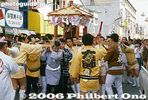
Old photoThis picture was taken in the 1980s.
|
|

The red cloth is the blood after the demon inside the vagina bit the phallus (Old photo)This picture was taken in the 1980s.
|
|

Portable shrine procession 神輿の巡幸
|
|

Portable shrine procession
|
|

Art work on the cart
|
|

Portable shrine procession
|
|

Head of the portable shrine processionTengu, shrine priest, and a little girl with an offertory tray. I put in 10 yen, and a shrine maiden came up to me and waved the sacred branch over my head as a blessing. She also gave me an amulet made of paper. I guess I'm fertile now...
|
|

Tengu (nose is not shaped like a phallus)
|
|

Kanayama Shrine's head priest
|
|

Portable shrine procession
|
|

Kanamara boat mikoshi
|
|
|

They are shouting, "Dekkai-mara Dekkai-mara" which probably means "huge phallus."
|
|

Elizabeth mikoshi carried by she-males
|
|

Elizabeth mikoshi carried by she-males
|
|

She-male (or maybe just a drag queen, I couldn't visually or physically confirm)
|
|

Entering the main shopping street
|
|

Elizabeth mikoshi carried by she-males
|
|

Maid with paws...
|
|

Kanamara mikoshi
|
|

Kanamara mikoshi
|
|
|
|

One of many daruma shops in the town.
|
|

Turning around at the end of the route.
|
|

Back at the shrine
|
|

Ceremony back at the shrine
|
|

Amulets, votive tablets, etc., for sale by the shrine.
|
|

Male and female made of mochi (1000 yen)
|
|

Hula dancing at a phallus festival?? (Click photo to learn why.)Because hula can also be considered as a sexually-suggestive dance. The way they sway the hips, etc., can be sexy enough to stir up your loins...
|
|

Hula
|
|

Hula and cherry blossoms
|
|

Hula and cherry blossoms
|
|

Hula and cherry blossoms
|
|

Hula and cherry blossoms
|
|
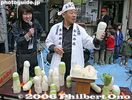
Phallus daikon radish auction, minimum bid 200 yenAll the daikon they were carving earlier in the day were sold at an auction. Most were sold for a few hundred yen. They even had an English interpreter (woman on left) so foreigners could bid too.
|
|

Two for the price of one!!
|
|

Look, this one even has wrinkles (probably flaccid).Yes, he actually said that.
|
|

Not exactly a work of art, but...
|
|

Items for the auction's climax...
|
|
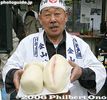
Male and female made of mochi. Both were offerings at the shrine.
|
|

Now this is a work of art. Bid at least 3,000 yen please...A Japanese woman bought this, but no takers for the mochi phallus (also 3,000 yen minimum).
|
|

Dance
|
|

Even a rock band played...They played '70s rock.
|
|

Long line at the lollipop stand...
|
|

Handmade male/female lollipops for 600 yen each
|
|

Lollipop maker, very popular
|
|

Lollipops (mass produced)The wrapping is printed with a prayer for conceiving.
|
|

Male and female lollipops (mass produced). Cute, but we all prefer the real thing, right?
|
|
|
|
|